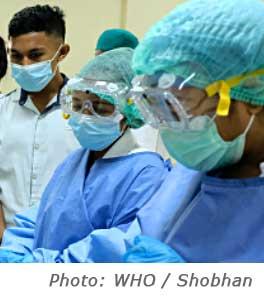Back to News page


Influenza preparedness underpins COVID-19 lab capacities in South East Asia
Date
August 3, 2020
Region
European Region
Every country in the WHO South-East Asia region (SEAR) has successfully established diagnostic capacity for COVID-19 and ensured a robust laboratory response to the pandemic. Their success was enabled in large part by a decade of preparedness activities in the region to build laboratory capacities for pandemic influenza.
The long-standing laboratory capacity building for influenza in SEAR has been made possible through a combination of national contributions coupled with funds from the Pandemic Influenza Preparedness Framework Partnership Contribution (PIP PC) and a range of other donors. Three areas of this support have proved particularly fruitful in enabling SEAR’s laboratory response to COVID-19:
- PCR diagnostic capacity building. By 2019, all 11 SEAR countries had built the capacity to accurately and reliably detect influenza viruses through real-time PCR, as recognized by the 2019 WHO External Quality Assessment Project (EQAP). This achievement was instrumental in providing the basis for COVID-19 PCR testing in the region. All SEAR countries are able to detect COVID-19 through real-time PCR. Six of these have already completed the 2020 COVID-19 EQAP test and achieved 100%; the rest are still waiting to receive or report on the EQAP panels.
- Online knowledge exchange. Since September 2019, WHO has hosted a series of regional webinars to share laboratory expertise and support online training within National Influenza Centres and public health laboratories involved in the diagnosis and surveillance of influenza. These laboratories now find themselves on the front line of COVID-19 detection and the webinars have been rapidly adapted to support this new role by focusing on COVID-19-specific laboratory topics, such as biosafety, specimen collection and transport, and data management.
- Laboratory assessment. During 2019, at least five South-East Asian countries assessed their national laboratory systems using WHO’s Laboratory Assessment Tool. They used the results to identify strengths and gaps in their laboratory capacities for influenza and to work towards addressing these. There is little doubt that this capacity building groundwork was critical in enabling laboratories to handle the surge in demand for laboratory services prompted by the COVID-19 response.